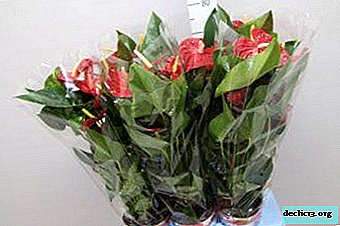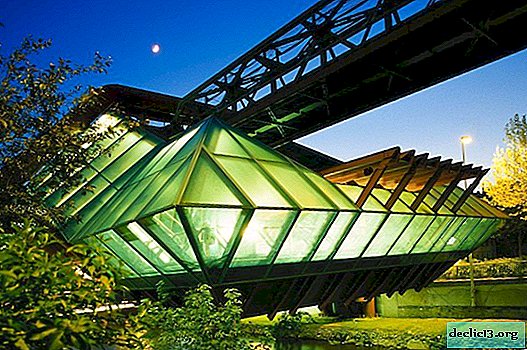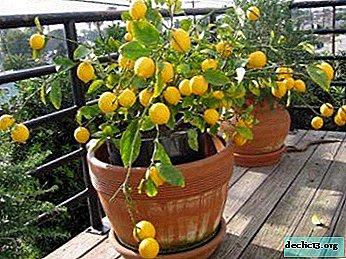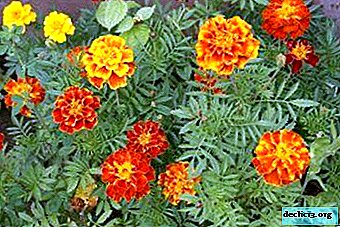Practical recommendations for planting youngsters and their subsequent care at home
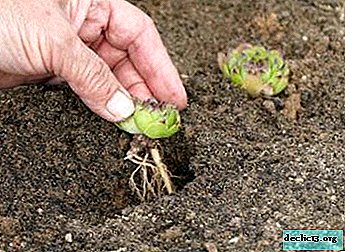
Sempervivum, or stone rose, is an exotic flower that feels great both on the garden plot and on the window sills of apartments and offices.
Especially original look combinations of several species, due to the diverse color and shape of the leaves.
The creation of such compositions implies the presence of a certain number of instances of a stone rose. Young plants can be obtained at home, you just need to follow the rules of planting and care for this unusual flower.
What time of the year is it better to plant juveniles?
The most favorable period for planting is spring - a time of active growth. Young plants will take root well before the frost, take root, gain strength and nutrients for the winter phase of rest.
What soil is needed?
Stone rose is suitable for light, loose sandy soil, neutral or slightly alkaline. The soil must pass moisture well. It is best to buy ready-made soil for cacti in a specialized store. Add fine charcoal and expanded clay there.
Reproduction methods, their pros and cons
Reproduction of a stone rose at home can be done in two ways:
- vegetatively - with the help of daughter layers;
- from the seeds.
Seeds
The main advantage is that this method is suitable for breeding new varieties. A variety of specimens can be grown from seeds obtained from a single plant.
The disadvantages of this method of reproduction are as follows:
 This is a more complex and time-consuming process than reproduction with the help of children.
This is a more complex and time-consuming process than reproduction with the help of children.- Young plants do not retain the varietal traits of their parents. At home, not very interesting specimens often grow.
- At home, it is quite problematic to get seeds. This requires two simultaneously flowering stone roses grown from different parents. In addition, as soon as the flowers begin to fade, they must be torn off urgently. Otherwise, the peduncle will dry out, and with it the entire outlet dies.Important! If you remove the flower early, the seeds do not have time to ripen, if you let the flower stalk dry, you can lose the whole plant, which is not advisable.
Kids
Florists prefer to propagate a stone rose with the help of children. This is due to the presence of a number of advantages of this method. The advantages of the method are:
- Ease. In the axils of the leaves of an adult plant, daughter sockets are formed. They are connected with the maternal base by thin stems. Having gained a little strength, small sockets crumble to the ground. They must be collected and planted. You can not wait for this moment and carefully separate the young plants from the mother, then spread on the soil.
- Reliability. This method provides excellent results - plants take root better.
- The rooting process takes a little time. Kids take root very quickly.
The disadvantage can be considered the fact that at home the young grows rather poorly and gives few children.
The process of formation of daughter processes can be accelerated. To do this, give the stone rose a lot of light - place a pot of plants on a sunny windowsill.
Daylight hours must last at least ten hours. It is possible to use luminescent or special phytolamps for additional illumination. After a certain amount of time, children begin to form in the axils of the leaves.
Watch the video about the reproduction of young children:
How to choose kids?
Small daughter sockets are suitable for reproduction. Large processes after planting often bloom and die - flowering young growth occurs only once in the life of the plant. If the young growth is grown for the first time and there is no way to separate the baby from the mother base independently, the young shoot can be purchased in a specialized store or nursery.
How to plant a flower - step by step instructions
 Prepare the planting substrate and pot.
Prepare the planting substrate and pot.- Add charcoal and expanded clay to the soil.
- Place drainage at the bottom of the planting pot: pebbles, brick chips or expanded clay. The layer should occupy one third of the total capacity. This serves as a prevention of waterlogging.
- Pour on top a layer of soil mixture one to two centimeters thick.
- Water the soil sparingly.
- Carefully separate the outlet from the mother base.
- Deepen the child layering into the ground.
- Pour in water at room temperature, avoiding moisture entering the outlet.
In the case when a very wide landing capacity is selected, the free surface of the earth can be covered with any natural material: pebbles, shells, cones, acorns.
Note! Some species grow whiskers - stems with a bud at the end, from which a young rosette is subsequently formed.In this case, you need:
- Loosen the ground, press the baby to it, sprinkle the mustache with a substrate or fix it with a hairpin.
- To water.
- You can not separate the new plant from the mother. If there is not enough space around the mother base, you should wait until the baby reaches at least two centimeters in diameter. Then you can trim the mustache so that it remains with the daughter process.
- It is necessary to put a small outlet in the hole, while deepening the mustache. It serves as the future pivotal root.
How to care for the first time after the procedure?
Temperature conditions
 The air temperature should be positive. In the summer, juvenile easily tolerates heat, but it is desirable to provide the plant with a temperature of no higher than + 27 ° C.
The air temperature should be positive. In the summer, juvenile easily tolerates heat, but it is desirable to provide the plant with a temperature of no higher than + 27 ° C.
The main thing is to timely ventilate the room - a stone rose loves fresh air. In spring and until late autumn, youngsters feel very comfortable on the balcony.
In winter, the indicators should be in the range of 10-15 ° C. The plant is able to withstand lowering to + 5 ° C. In conditions of zero or negative temperature, juvenile dies. In winter, airing is also mandatory, so it is better to rearrange the flower in the depths of the room, away from the frosty air of an open window.
Lighting
Stone rose is a photophilous plant. A pot with a young outlet needs to be placed on the south window. In the summer at noon, it is advisable to shade the plant. If the flower is constantly in the shade, the young growth can turn pale, stretch out and lose its decorative effect.
Important! The windowsill, on which the plant stands, should be well lit by the sun. If the window is obscured by trees growing nearby, the stone rose will not receive enough sunlight.In winter, you can put a stone rose in a shaded place for a couple of months, providing the plant with a dormant state.
The soil
In nature, young growth is located on sandy and rocky soils. Growing a stone rose at home, you should create a flower conditions that are as close to natural as possible. Youngsters feel comfortable in well-drained, loose, poor soil, not clay and not acidic. The plant loves sand and humus. As a planting mixture, it is recommended to use a substrate for cacti, adding charcoal to it to control the level of soil moisture.
Before planting, it is important not to forget about the drainage, which should occupy one third of the volume of the pot. Stone rose has a small root system, the plant has enough space in the pot. Drainage provides quick water drainage and serves as a preventive measure of excess moisture. Crushed stone, brick chips, pebbles or expanded clay perfectly cope with these tasks.
Pot selection
You can put the baby separately in a small pot or take a large one and form a composition of young outlets. A light substrate and a compact root system allow you to choose a wide variety of containers for growing stone roses. The only important condition is the presence of a drainage hole at the bottom of the pot.
Top dressing
 After planting, fertilizer is not required. Fertilizers begin to give only to an adult plantwhose age is at least three years old.
After planting, fertilizer is not required. Fertilizers begin to give only to an adult plantwhose age is at least three years old.
Supplementary nutrition activates the development of the outlet, it is very stretched, turns pale and loses its attractiveness. The frost resistance of a stone rose is also significantly reduced.
The root system of the young is quite small, the plant does not need a transplant. Upon reaching four years, the soil, which contains a stone rose, is depleted, which can cause withering of the young.
Older plants need to be fed liquid fertilizer for cacti. This should be done very carefully. It is recommended to use half the norm of feeding. Fertilizing in the soil is worth once every one to two months, starting in early spring.
Watering
Leaving after planting consists of regular moderate soil moisture. Excessive watering can cause leaf decay and death of young. To prevent rot and mold, it is recommended to alternate plain water and a 0.5% solution of any fungicide. It is important to ensure that the surface of the earth remains slightly moist.
Note! Do not allow water to enter the outlet. Watering should be under the root.Youngsters perceive drought very well, but the overflow is very difficult. In the warm season, moistening the soil must be done once every two weeks, with the onset of winter - once a month.
If the lower leaves wilt, watering is required to be reduced. Do not place a stone rose pot near plants that need to be sprayed. The description and nuances of caring for a stone rose at home can be found in this article.
What to do if the plant does not take root?
Sempervivum is absolutely not a demanding flower and takes root at home very successfully. Problems after landing rarely occur and are most often associated with a gross violation of the conditions of detention.
- If the stone rose does not take root, you need to check the soil moisture level. Extremely rare watering does not allow the roots of a young outlet to develop. In order for the daughter process to take root, it is necessary to moisten the soil regularly.
- In the case when the plant withers and traces of rot appear on it, it is urgent to free the young growth from the ground, clean the unhealthy parts and root again in fresh soil. Reduce watering, avoiding excessive waterlogging of the substrate.
Thinning is an easy-to-care and very original plant, with the content and reproduction of which even a beginner grower will cope. A rich variety of species and following the elementary rules of cultivation allow you to collect on the windowsill a spectacular collection of stone rose specimens.

 This is a more complex and time-consuming process than reproduction with the help of children.
This is a more complex and time-consuming process than reproduction with the help of children. Prepare the planting substrate and pot.
Prepare the planting substrate and pot.




